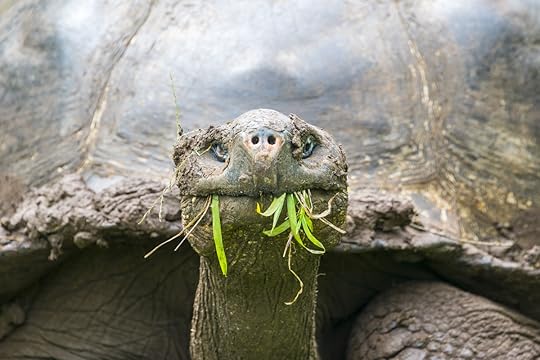Ripley Entertainment Inc.'s Blog, page 21
June 22, 2023
CARTOON 06-22-2023
June 21, 2023
Live Long And Prosper: The Longest Living Animals On Earth
Featured in Ripley's Believe It or Not!

There are no friends quite as loyal, quite as adorable, quite as likely to be distracted by a laser-dot on the floor for fifteen minutes straight, as our pets.
Dogs and cats, are incredibly popular pets. The only issue with them, as any canine- or feline-lover will tell you, is that they just don’t live as long as we wish they could. The average life expectancy for a dog varies by breed from 12.7 years (for a Jack Russell Terrier) to just 4.5 years (French Bulldogs). With cats, meanwhile, it’s up to around 15 years.
There are remarkable exceptions to these rules, though: In May 2023, a cat named Rosie, of Norwich in England, had a salmon cake to celebrate her 32nd birthday!
Orcas, Parrots And Other Surprisingly Long-Lived AnimalsSome exotic pets can live much longer. Different breeds of parrot, for instance, have lifespans so long that owners also tend to need to make contingency plans for when they’re outlived by their feathered friend. The oldest recorded parrot was Cookie the cockatoo, who lived to be 82. Even more remarkable, though unverified, is the tale of Charlie, the blue-and-gold macaw, who supposedly lived to 114 years old and was once owned by Winston Churchill himself!
Cookie, the ‘world’s oldest’ cockatoo, has died at the age of 83 pic.twitter.com/X8iFYVT5sd
— ITV News (@itvnews) August 31, 2016
The average human life expectancy at birth is approximately 73 years, according to the World Health Organization. Species that can match or beat this tend to be the exception, not the rule. In such cases, unique individuals such as Cookie make headlines. Another potential example is the remarkable orca dubbed Granny, who reportedly led a Pacific Northwest pod of orca and is believed to have died in 2017, at an age of perhaps up to 105.
Remarkable longevity has been noted in many species, but as with Granny, the issue of accurate age verification remains. On top of which, particular specimens that live to extraordinary ages for their species don’t get us any closer to tackling the true heart of the issue: which animal species live the longest?
When it comes to the longest-living animal species, the answer is quite complicated.
Jell-ous Of Their Lifespan?There are a lot of factors to consider, one being how we choose to define a life span. From birth to death seems simple enough, yes, but some sneaky creatures have a phoenix-esque ability to reset that process and become “infants” again.
The Immortal Jellyfish, as its impressive name implies, could, theoretically, live forever. It’s not the most imposing of creatures, at a teeny 4.5 millimeters in length, but it has one of the most astonishing and enviable abilities in the animal kingdom.
It grows from a larva to a polyp to a medusa (think child to teenager to adult in our terms), as is the norm for so many jellyfish species. What sets Turritopsis dohrnii and a select few other species like the moon jellyfish apart, though, is the fact that the medusa can also revert back through those stages. The creatures seem to be able to activate this state at will, as a response to threats to their lives. They are also able to do so repeatedly (more research is required to discover just how many times)!

Turritopsis dohrnii, also known as the immortal jellyfish.
Such jellyfish, then, have the potential to be the longest-living animals on Earth. It’s important to note, though, that they seem to have several regular-length lives, rather than one long lifespan.
The Humble Clam That Beats Them AllWhen it comes to remarkable lifespans, the Galápagos Tortoise is one of the most famous examples. Who could forget the story of Australia Zoo’s beloved Harriet, who was reportedly acquired at her homeland by Charles Darwin himself in the 1830s? She went on to become one of the zoo’s most famous residents (which is saying something, considering it was also the home of wildlife icon Steve Irwin), passing away in June 2006 having celebrated her 175th birthday the previous year.
These great tortoises, which can reach around five feet long, are noted by National Geographic to be among the Earth’s longest-living terrestrial animals. A century or so is nothing special for a Galápagos Tortoise, and though Harriet was the oldest on record, there may well have been others of her species who outlived (or will outlive) her.
What of ocean-dwelling animals? Like the immortal jellyfish, there are other species that live to incredible ages under the sea. The Wildlife Trusts declares the ocean quahog, a bivalve mollusk that frequents the beaches of the United Kingdom to be “the longest-lived animal known to man,” stating that one verified clam lived to an extraordinary 507 years old!
This, of course, far outstrips Harriet the tortoise’s extraordinary life, but before the clam claims the crown and hurries away (though clams don’t tend to be renowned for “hurrying” anywhere), there are other ocean dwellers to consider.
Biological immortality is a state in which the rate of mortality from senescence is stable or decreasing, thus decoupling it from chronological age. Ming the clam was an Arctica islandica that lived for approximately 507 years:
[read more: https://t.co/Bir8JF7K5X] pic.twitter.com/ALHVjHHQM0
— Massimo (@Rainmaker1973) April 26, 2023
The Hexactinellid sponge may be the ultimate example: The cold of the Antarctic reportedly slows their growth to a glacial pace, and allows these curious creatures to live for a long, long time indeed: In one instance, a particularly large sponge was thought to be 23,000 years old, though the logistics of it all made determining this accurately impossible. Even 15,000 years, a revised estimate, could be far too generous, but astonishing to even think about nonetheless.
The National Ocean Service regards the quahog as the longest-lived animal on Earth, celebrating the bowhead whale, which can live for more than 200 years, as the runner-up. Whales in general, it notes, have the greatest lifespans of any mammals.
In terms of animals and lifespans as they tend to be defined, the humble ocean quahog is the world’s longest living animal. The sponge may take the prize if the discussion is expanded to living beings of any description, but for now at least, it’s proven too difficult to determine that with certainty.
Yet more contenders exist for that prize: In Oregon’s Malheur National Forest lives a vast honey mushroom cluster. Its exact age is also unknown, but science puts its lifespan at around 8,650! The candles on that cake would be a sight to behold indeed.
By Chris Littlechild, contributor for Ripleys.com
EXPLORE THE ODD IN PERSON! Discover hundreds of strange and unusual artifacts and get hands-on with unbelievable interactives when you visit a Ripley’s Odditorium!Source: Live Long And Prosper: The Longest Living Animals On Earth
CARTOON 06-21-2023
June 20, 2023
The Weirdest Water Stories of 2023 (So Far!)
Featured in Ripley's Believe It or Not!

2023 has become the year for watching the water. (And, in some cases, doing a double take!) That’s because unbelievable sights and animals have surfaced in recent months, challenging world records and what we know about the deep blue. What are some of the strangest things to emerge? Everything from record-shattering divers to fish of unusual size (F.O.U.S.?).
Keep reading as we take a closer look at some of the most fascinating stories to surface from the waves.
“Dr. Deep” Submerges for One-Third of the YearSpending nearly 30 percent of the year underwater isn’t for the faint of heart. Or most of the world’s population, for that matter. But don’t tell that to Florida’s “Dr. Deep”! The University of South Florida professor recently completed 100 days beneath the waves at a scuba diver lodge in the Florida Keys. Known as Jules’ Undersea Lodge, his extended accommodations sit 30 feet beneath Key Largo lagoon.
“Dr. Deep” (a.k.a. Dr. Joseph Dituri) is a medical researcher and diving explorer. He boasts a doctorate in biomedical engineering and is also a U.S. Navy veteran. He shattered the previous record of 73 days held by two Tennessee professors since 2014. Incidentally, they established this record at the same lodge.
Why the desire to stay underwater for so long? According to Dituri, it was never about breaking the world record. Instead, he explains, “It was about extending human tolerance for the underwater world and for an isolated, confined extreme environment.”
Embed from Getty Imageswindow.gie=window.gie||function(c){(gie.q=gie.q||[]).push(c)};gie(function(){gie.widgets.load({id:'l9FUd8u7Rrxq7_Fr9wIhpA',sig:'KJXqtq_dL84545voYZD5ZcZANzovEoSKVn4vA-zsBwg=',w:'594px',h:'374px',items:'1258566357',caption: true ,tld:'com',is360: false })});During his more than three months below, Dituri conducted daily experiments and monitored how his body responded to extreme conditions. He labeled the endeavor Project Neptune. Dituri will present Project Neptune’s findings at the end of the year at Scotland’s World Extreme Medicine Conference.
Whale Watchers Get a Killer SurpriseSan Francisco’s coastline became ground zero for an unusual sight on May 7th. That’s when a whale-watching tour on the hunt for migrating gray and humpback whales came across a massive pod of orcas.
While seeing killer whales off the Pacific Coast is always possible, they typically prefer the deep waters off the coast of Monterey Bay. For context, that’s roughly 75 miles south of the city.
But this pod appeared near the Farallon Islands, likely celebrating a successful seal or sea lion hunt. The pod included 20+ individuals, a big jump from the three to five usually observed swimming in family groups.
The males in the various pods made an impression with their six-foot-tall dorsal fins. But whale watchers proved even more entranced by the group’s orca mothers and calves. Nancy Black of Monterey Bay Whale Watch notes, “They’re the whale that most people want to see when they go whale-watching. You just don’t know when they’re going to be around.”
Surfers Conquer the World’s Longest-Lasting WavesDuring the first weekend of June, surfers across Brazil flocked to the Amazon River’s mouth near Chaves. Why? To catch the world’s longest-lasting waves. These waves occur when the incoming tide rushes up the river, creating a broad band of waves surfable for miles.
Under the right conditions, these massive waves happen twice a day. In recent years, they’ve inspired a festival known as “Pororoca.” (Pororoca translates as “destructor” or big roar” and comes from an indigenous term.)
The festival moves from riverside town to riverside town in the states of Maranhao, Amapa, and Para for nearly a week. This relocation reflects the daily movement of the meeting point between the Atlantic Ocean and the Amazon River.
The waves prove exceptionally long and powerful around the new and full moons. The reason? The ocean’s tide reaches its highest point. Once upon a time, Pororoca portended disaster, but surfing has changed how locals view this natural phenomenon.
Noélio Sobrinho, president of the Brazilian Pororoca Surfing Association, explains, “Pororoca has always been synonymous with tragedy and destruction. After we started surfing the wave, … Pororoca went from villain to artist. Today it is one of the main sources of tourism here in Chaves.”
A Fish of a TaleLocated in the Lombardy region of northern Italy, the River Po is the nation’s longest. Its shallow waters provide habitat for large fish, namely the Wels catfish. These freshwater behemoths lurk in its murky waters preying on anything they can get their mouths around.
But nobody was prepared for the goliath recently pulled from the river’s waters by Alessandro Biancardi. The Italian fisherman reeled in a one-of-a-kind catch, a 9.4-foot-long beast. Photos of the monstrous prize quickly took the internet by storm, from its slimy marbled skin to its gigantic whiskers.
Biancardi relates, “When it surfaced for the first time, I really realized that I hooked a monster. I was also facing the biggest catfish I [have] ever seen in 23 years.” Despite the size of this individual, big fish are far from rare in southern Europe.
Warm temperatures and abundant food encourage dramatic and rapid growth. For example, the fish brought in by Biancardi is estimated to be between 20 and 30 years old. But in colder climates, like those in Scandinavia, it takes 100 years for a fish to reach a comparable size.
Of course, all of this begs a vitally important question. Baked catfish puttanesca, anyone?
By Engrid Barnett, contributor for Ripleys.com
EXPLORE THE ODD IN PERSON! Discover hundreds of strange and unusual artifacts and get hands-on with unbelievable interactives when you visit a Ripley’s Odditorium!CARTOON 06-20-2023
June 19, 2023
CARTOON 06-19-2023
June 18, 2023
CARTOON 06-18-2023
June 17, 2023
CARTOON 06-17-2023
June 16, 2023
Up Close & Peculiar: Joe Frazier’s Iconic Jockstrap
Featured in Ripley's Believe It or Not!

Today: Joe Frazier’s Jockstrap
It may look like I have been rummaging through someone’s underwear drawer, but what I have here is actually a pretty significant piece of boxing history. This is Joe Frazier’s jockstrap that he wore in his famous 1971 fight against Muhammid Ali.
In 1971, the world was eagerly anticipating the “Fight of the Century” between two boxing legends: Muhammad Ali and Joe Frazier. Ali, the former heavyweight champion, had been stripped of his title due to his refusal to be drafted into the Vietnam War. Frazier, meanwhile, had recently won the title and was eager to prove that he was the true champion.
Believe It or Not! Joe Frazier used to work in a meat locker in Philadelphia and was known to punch the sides of the meat with his fists. Sound familiar? That’s because his unusual training tactics were the inspiration behind the meat locker storyline in Rocky!
The fight took place at Madison Square Garden in New York City on March 8th, 1971, and was a grueling 15-round battle that saw both fighters take punishing blows. In the end, Frazier emerged victorious, handing Ali his first professional loss.
Were you one of the 300 million viewers back in 1971? Let us know in the comments and I’ll see you next time!
EXPLORE THE ODD IN PERSON! Discover hundreds of strange and unusual artifacts and get hands-on with unbelievable interactives when you visit a Ripley’s Odditorium!Family Finds Hidden Crawl Space With 1 Million Pennies Inside
Featured in Ripley's Believe It or Not!

What would you do if you found 1 million pennies? A family in California found a gigantic hidden stash of the copper coins, but they are having a difficult time cashing them in. Even banks do not want to deal with the hassle of all those pennies, which would take two to three trucks to move. Some of the coins are still contained in bank-sealed bags and boxes. Some are from financial institutions that no longer exist.
One Too PennyLast fall, John Reyes and his cousin were cleaning out the basement of Reyes’ late father-in-law’s house when they discovered dozens of bags and boxes in the crawl space filled with an estimated 1 million pennies worth around $10,000, reports the New York Times.
Their penny jackpot is not the boon you would think it would be. The first obstacle was physically removing the pennies from the crawl space. Reyes explained that moving the haul left imprints on his fingers because the bags and boxes were so heavy.
The find was certainly unexpected. Reyes told the NYT: “All we could think was how in the world did my father-in-law and his brother do this on their own? Crazy.”
On the plus side, each parcel has the number of pennies inside written on the outside, making that part of the process a little easier.
Reyes nixed the idea of using a Coinstar machine to convert the pennies because the company charges an 11.9-percent processing fee for each transaction. When he attempted to take the pennies to local banks, he discovered that they did not want them. One bank did not even have a vault large enough to accommodate them.
A Wells Fargo manager, however, gave him a bit of hope, suggesting he may have a million-dollar penny within his haul. “That was one of the first times I had heard about pennies being worth more than a penny,” Reyes explained.
A Needle In A HaystackBefore World War II, pennies were made of pure copper. During the war, copper was used for ammunition and military equipment, so the coins were made of zinc-covered steel instead. Pennies made from 1982 onwards are largely zinc with just a little bit of copper.
Reyes’ father-in-law was a German immigrant who believed copper pennies would increase in value, so he and his brother started collecting them. He may have been on to something—sort of. There are some rare pennies that are valuable, particularly a collection from 1943 that was the result of a printing error. In 2022, one of these 1943 pennies sold for nearly $300,000.
But sifting through 1 million pennies for a rare one is like searching for a needle in a haystack. It is an arduous task that Reyes and his family are not interested in attempting. They have listed the lot on online sales marketplace OfferUp for $25,000. An interested buyer must pick them up. The listing notes that some of the coins may be valuable, but there is no guarantee.
Over 300 people have expressed interest in the pennies. The family just wants to sell the collection of pennies as is and is not interested in allowing potential buyers to go through them first and negotiate deals over potential rare coins.
Reyes has only examined about 1 or 2 percent of the pennies, so you can imagine the work required to go through all of them!
By Noelle Talmon, contributor for Ripleys.com
EXPLORE THE ODD IN PERSON! Discover hundreds of strange and unusual artifacts and get hands-on with unbelievable interactives when you visit a Ripley’s Odditorium!Source: Family Finds Hidden Crawl Space With 1 Million Pennies Inside
Ripley Entertainment Inc.'s Blog
- Ripley Entertainment Inc.'s profile
- 52 followers









